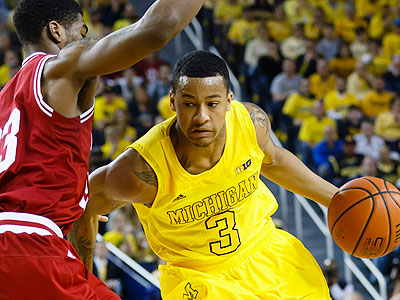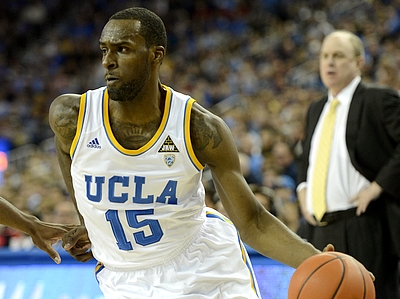There again appears to be quite a bit of confusion about the NBA's early-entry draft process amongst college players, college coaches, NBA personnel and media members, due to rule changes made by the NCAA in May of 2011 regarding collegiate eligibility.
To clear up some of the misinformation that is circulating, we've again collected all the appropriate information we think prospects will need in order to make an informed decision on whether or not to enter the NBA draft this spring.
First, the applicable dates:
April 10: NBA Undergraduate Advisory Committee Application Deadline
April 15: NBA Undergraduate Advisory Committee Response Deadline
April 16: NCAA Early Entry Withdrawal Deadline
April 28: NBA Draft Early Entry Eligibility Deadline (11:59 pm ET)
May 2: NBA Draft Early Entry Candidates Released Underclassmen Contact Permitted
May 15-19: NBA Draft Combine (Chicago)
May 21: NBA Draft Lottery
June 17: NBA Draft Early Entry Withdrawal Deadline (5:00 pm ET)
June 27: 2013 NBA Draft
The main change from what NCAA underclassmen were accustomed to in the past (prior to 2012) involves the NCAA's unilaterally imposed early-entry withdrawal deadline of April 16th.
According to NCAA Proposal No. 2010-24, student-athletes interested in 'testing the waters' of the NBA draft [are required] to remove their name from consideration before the first day of the spring National Letter of Intent signing period.
The first day of the spring National Letter of Intent signing period is April 17th this year, meaning that any player that makes himself eligible for the NBA draft before then must remove it by April 16th in order to retain his collegiate eligibility.
What this essentially means is that there is no testing the waters anymore.
The reason for this change, in the NCAA's words is: to help keep student-athletes focused on academics in the spring term and to give coaches a better idea of their roster for the coming year before the recruiting period is closed.
This unilateral deadline imposed by the NCAA has been widely criticized by members of the basketball industry, as it is clearly a self-serving rule intended to protect the NCAA's own economic interests by severely restricting players' ability to explore their professional options.
The way the rules are written, they're basically saying to the kids, We're just looking at the universities, we're not looking after you, Louisville head coach Rick Pitino said last month.
The NCAA Division I Men's Basketball Issues Committee understood the concerns surrounding this dramatic change, including the potential inability of student-athletes to gather all necessary information to make an informed decision, the disruption of team continuity during the latter part of the regular season/NCAA Division I Men's Basketball Championship tournament, and the increased media attention during the championship, but nonetheless elected to push forward with it, with no change in sight.
The biggest issue with this new early entry intention date of April 16 is that it falls less than two weeks before the NBA's own early-entry deadline of April 28th. Until the NBA officially disperses their list of underclassmen who have made themselves eligible for the NBA draft, usually four days after the deadline, teams cannot have any type of contact with those players, which obviously includes pre-draft workouts.
Since the NCAA bars third parties (even family members) of college players from reaching out to NBA teams to discuss their draft stock, and the NBA itself has strict no-contact rules regarding the way teams can communicate with players who are not officially draft-eligible (before the early-entry list is released in early May), the only way an underclassman can gather information about his draft stock is through his college head coach. Furthermore, the head coach is only allowed to talk with the principal basketball operations executive from each team (ie: the general manager), according to NBA rules, and the underclassman may not participate in or be present during any such conversation.
To help with this process, the NBA is again offering underclassmen the ability to get actual feedback from a group of executives representing 20 NBA teams selected by the League Office, and chaired by NBA Executive Vice President of Basketball Operations Stu Jackson, called the NBA Undergraduate Advisory Committee.
According to NBA spokesman Tim Frank, who we corresponded with via email in researching this article, this committee consists of General Managers, Assistant General Managers, and VP's of Player Personnel and the like who scout college basketball extensively during the college basketball season.
NCAA underclassmen must apply for an evaluation in writing no later than April 10 th, which is two days after the Championship game of the NCAA tournament in Atlanta.
The NBA Undergraduate Advisory Committee will deliver their evaluation on or before April 15th.
According to NBA spokesman Tim Frank once the committee does their analysis of the player, the draft projection is communicated to the player, coach, or anyone else who the player designates, such as family, in a phone call in which the draft projection is shared and the player (or others involved) can ask questions about the projection and the draft process.
Frank also explained via email that we instruct our Committee members to provide as narrow of a draft range as they can with confidence, and they are not limited to the lottery, first round, second round, not drafted framework and other more specific descriptors covering ranges are much more commonly used. We collect the projections from our Committee members and summarize this information to the players and others who they designate, and the draft projections and ranges obviously vary based upon the given prospect.
What's important to note (and has been widely misreported in the media), is that requesting an evaluation from the advisory committee does not constitute entering the draft. In fact, the application form explicitly states that this application is not a declaration of eligibility for the 2013 NBA draft. A separate letter must be sent to Commission David Stern (received by April 28, 2013) declaring eligibility for the 2013 NBA draft. An application form for the 2013 NBA draft will be sent upon receipt of the letter of declaration.
What that means is that, theoretically, a college player could still wait until April 28th to enter the NBA draft, as these are two separate deadlines, and there seemingly is no benefit at all to entering his name before, particularly since he will lose his NCAA eligibility if he does not remove it before April 16th.
For example, if a player seriously injures himself between April 17th and April 28th, but had already sent a letter to David Stern declaring their eligibility for the 2013 NBA Draft, that player would be ineligible to return to school.
While college coaches would obviously love to have all of their answers regarding who will or will not return to their team by April 16th, so they can start their vacation early or get an early jump on next season, realistically there is no reason why an underclassmen wouldn't continue to privately investigate their NBA draft stock until April 28th.
Is the NBA Undergraduate Advisory Committee the answer then? While it's certainly noble of the NBA to try an assist with the process, it remains extremely difficult for a player to get an accurate gauge of their draft stock in April, as there are just too many variables to predict that are out of anyone's control.
The NBA realizes as much, and has no qualms informing prospects of such, as you can read in the advisory committee application below: The Committee's evaluation is, of course, only an educated assessment and is not binding in any way or a commitment of guarantee that a player will or will not be drafted in a certain slot or at all.
Most NBA teams will still be in very preliminary stages of their evaluation process in April, and may not be in a position to tell an underclassman with any real accuracy where he will be drafted on June 27th.
As veteran NBA agent Mark Bartelstein told ESPN's Andy Katz last year: There are no sure answers in January, February or March. No one knows in even late April what's happening [with the draft]. You're asking kids to make decisions without accurate information. Teams don't know what they're doing. It's going to be a nightmare for college coaches
There will be all kinds of people telling [players] what they want to hear and don't have the real answer.
From what we've gathered, the NBA Undergraduate Advisory Committee has traditionally been very conservative with the evaluations they've provided players. The last thing they want is to tell an underclassman they are a sure-fire first rounder in early April, only to see them slip into the second round or go undrafted in late June. That's why it's understandable that they would err on the side of caution.
Andrew Bynum for example was told by the advisory committee that he is a late first round, early second round pick according to a person involved in his decision, but ended up being drafted in the top-10. Kevin Martin was told that his projection was late second round to undrafted, but was eventually picked in the first round. There are countless other examples.
Private workouts conducted in June in front of coaching staffs can and will shift a player's draft stock dramatically in either direction, as can the results of the NBA combine, medical examinations, game film study and background intel sessions. Some underclassmen's stock will rise significantlysuch as Dion Waiters or Jared Cunningham last yearand some will fallsuch as Perry Jones, Jared Sullinger, Quincy Miller or Doron Lamb.
Although the rules are very strict about how and when NBA teams can communicate with underclassmen, in actuality these conversations happen all year through back channel conversations.
While the May 8th withdrawal deadline that was in effect in 2011 wasn't ideal by any stretch, because it only allowed players to participate in a maximum of one or two NBA workouts, it still was far better than what is in place now, which allows for zero. With the previous deadline, players and their families enjoyed an entire week of unlimited contact with all 30 NBA teams. In that span an underclassman could call NBA executives directly and get individually tailored assessments about their standing with their organization, which is obviously far preferable.
With the situation that is in place now, a large number of players will be forced to make career-altering decisions with an impossibly small amount of information on April 28th (or if the NCAA and their arbitrary dates will have their wayApril 16th), something that benefits no one.
For reference, here is last year's letter from Stu Jackson, Executive Vice President Basketball Operations to NCAA Coaches
[NBA letterhead]
March 1, 2012
Dear Coach:
The National Basketball Association in consultation with the NCAA will again this year establish an Undergraduate Advisory Committee in preparation for the NBA Draft. The purpose of the Advisory Committee is to provide underclassmen who are thinking of turning professional with an objective evaluation of their prospects in the 2012 NBA Draft.
The Advisory Committee will consistent of NBA player personnel experts and will be chaired by me. Players must apply in writing for an evaluation after the conclusion of their collegiate season (including all tournament games) but prior to April 3, 2012. After receipt of the application, the Advisory Committee attempts to determine whether, in the opinion of the Committee, such player is likely to be drafted in the upcoming NBA Draft, and, if so, whether such player is likely to be a lottery pick (i.e., one of the first fourteen picks), a first round pick (i.e. one of the first thirty picks), or a second round pick (i.e., picked somewhere between thirty-one and sixty). On or before April 6, 2012, either I or someone from my staff will communicate the foregoing information to the player and/or his college coach.
The Committee's evaluation is, of course, only an educated assessment and is not binding in any way or a commitment of guarantee that a player will or will not be drafted in a certain slot or at all. Please also understand that the Committee's evaluation should in no way be viewed as an effort to encourage the player to leave school, the Committee is simply responding to a request for information. Neither the player, the coach, nor any representatives of either may make any of the information communicated by the Committee public.
Enclosed you will find an application the must be filled out in its entirety by the player and the coach. It must be received by my office (by mail or fax to the address or fax number noted on the bottom of the enclosed application) on or before April 3, 2012, in order for the player to be evaluated by the Committee
If you have any questions, please call Ned Cohen at (212) xxx-xxxx
Sincerely
Stu Jackson
Executive Vice President
Basketball Operations
[page 2]
NBA UNDERGRADUATE ADVISORY COMMITTEE
Application for Evaluation
Player's Full Name: ________________________________________
University: _______________________________________________
Player's Telephone Number in March/April: ____________________
Player's Address in March/April: ______________________________
Coach: __________________________________________________
Coach's Telephone Number: _________________________________
We the undersigned, with to inquire as to the potential of the player listed above (Player) being drafted in the 2012 NBA Draft. We understand that, in response to this request, the NBA Advisory Committee will give us its best estimate of the likelihood of Player being drafted in the 2012 NBA Draft and, if so, whether Player is like to be a lottery pick (i.e., one of the first fourteen picks), a first round pick, or a second round pick. The Committee will not give us any information concerning the likelihood of Player (i) making an NBA roster if drafted and (ii) being signed as a free agent if not drafted.
We further understand that the Committee's evaluation (and all information communicated to us by the NBA and/or the Committee concerning Player's possible draft status) is non-bind and is in no way a commitment or guarantee that Player will or will not be drafted in a certain slot or at all. By our signatures below, we promise to keep all information communicated to us by the Committee confidential and we forever waive any claim either of us (or any of our representatives, heirs, or assigns) may have against the NBA, its member teams, the NBA Advisory Committee or any of their affiliates, representatives or employees concerning the NBA Undergraduate Advisory Committee or theCommittee's evaluation of the Player
Please note that Submission of this application is not a declaration of eligibility for the 2012 NBA Draft. A separate letter must be sent to Commissioner David Stern (received by April 29, 2012) declaring eligibility for the 2012 NBA Draft. An application form for the 2012 Draft will be sent upon receipt of the letter of declaration.
Signature of Player: ________________________________________
Signature of Coach: ________________________________________
Date Application Submitted to Address or Fax Number Listed Below
NBA Undergraduate Advisory Committee
c/o NBA Basketball Operations Department
645 Fifth Avenue
New York, NY 10022
Fax Number (212) xxx-xxxx
Testing the NBA Draft Waters in 2013

Mar 19, 2013, 08:30 pm
Read Next...
-
Day Three NCAA Tournament NBA Draft Prospect Viewing Guide
Mar 22, 2013, 08:32 pmThe name on the back of the jersey means just as much as the name on the front here at DraftExpress, so if you're watching the tournament with an eye on scouting players who will eventually play in the NBA, you've come to the right place. -
Day Two NCAA Tournament NBA Draft Prospect Viewing Guide
Mar 21, 2013, 09:45 pmThe name on the back of the jersey means just as much as the name on the front here at DraftExpress, so if youre watching the NCAA tournament with an eye on scouting future NBA players, youve come to the right place.
























Comments